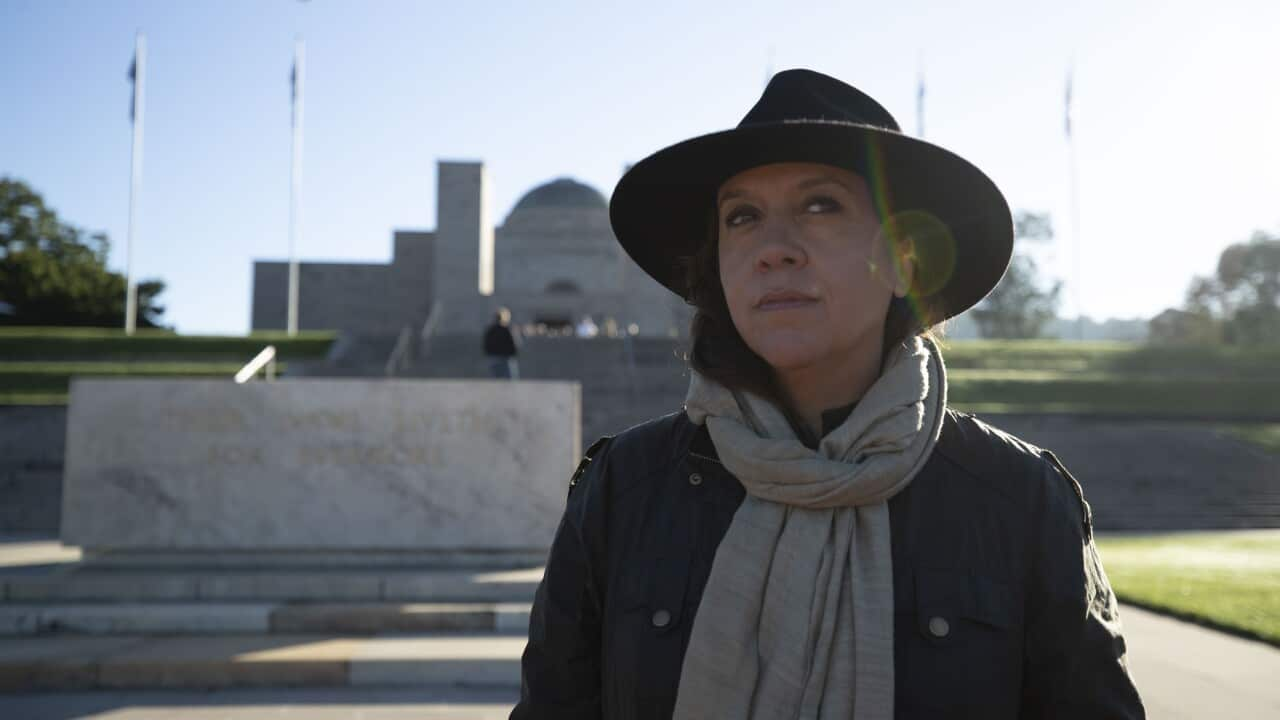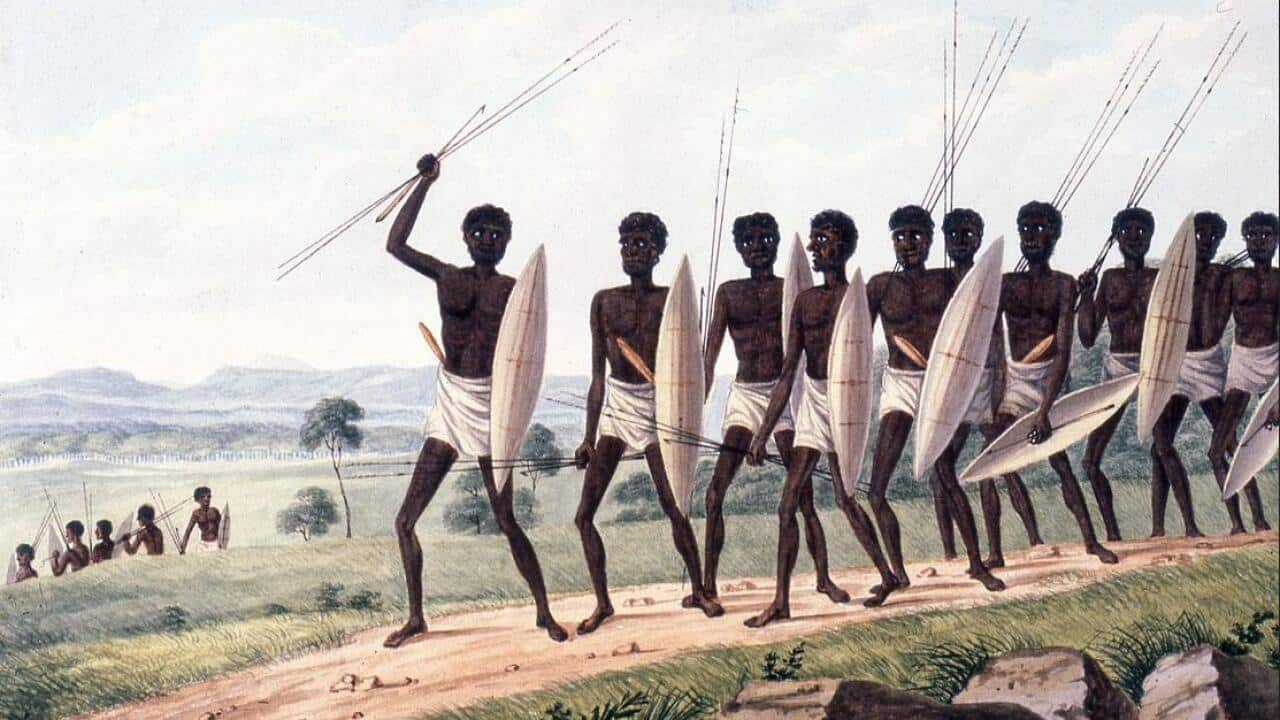WARNING: This article contains depictions of violence.
220 years ago, a gunshot cracked across Dharug Country, splitting the peaceful air of that land.
It was a sound that, just 30 years earlier, had never been heard in those parts, but had increasingly come to haunt the people who lived there.
The British invasion of the sovereign Aboriginal nations was underway. Initial efforts at conciliation, doomed from the beginning, had given way to violence, a war of Aboriginal resistance.
On June 1, 1802, that bullet became the full stop on the first sentence of a horrifying new chapter playing out across the continent: Pemulwuy, the leader of the first Blak resistance, was dead.
It was perhaps inevitable: the highest levels of British government had placed a price on Pemulwuy's head, sanctioning his capture or murder, enticing would-be bounty hunters with lavish gifts. Even so, it would take twelve years to bring him down, during which time Pemulwuy waged a successful guerrilla war against the most powerful empire the world had ever seen.
A new documentary series to air on NITV/SBS, The Australian Wars will examine the horrors of colonisation, and the brave actions of men and women who defended their people from a terrible enemy, as Pemulwuy did.
How did one man become such a feared symbol of Aboriginal resistance, a long-standing thorn in the side of colonisers, and a threat to the success of the British Empire's invasion?
The Bidjigal Cleverman

This engraving by Samuel John Neele of James Grant's image of 'Pimbloy' is believed to be the only known contemporary depiction of the Bidjigal resistance leader Pemulwuy. Source: State Library of Victoria
The Bidjigal were significant in the region: their Country ‘stretched from Botany Bay south of the Cooks River and west along the Georges River to Salt Pan Creek, south of Bankstown.’ And within that significant clan, Pemulwuy was a significant person.
He cut an imposing physical figure: a tall and muscular man, his left eye was 'blemished', and one foot turned. Though the English believed he was born club-footed, it is likely that Pemulwuy was a Carradhy, a Cleverman, and that the injury to his foot was the result of an initiation ceremony.
He ranged freely across all the lands of the Sydney basin, marking him as a person of great standing.
In other words, in the years before 1788, he enjoyed status, respect, and a cultural life on the generous lands of modern day Sydney, like all his people.
An enemy arrives

The arrival of the First Fleet in January 1788 heralded the beginning of a terrifying new chapter in the continent's history.
The initial meetings between the English and the people of the Eora, Dharug, Kuringgai and Dharawal nations were civil. Phillip, a man who believed in Enlightenment ideals, to 'conciliate their affections', to 'live in amity and kindness with them', and to punish anyone who should 'wantonly destroy them, or give them any unnecessary interruption in the exercise of their several occupations'.
But the fundamental flaw at the heart of these ostensibly pacific instructions was the concept of terra nullius, and the central purpose of the colonists, namely, to take the land for themselves.
The locals, for their part, were seemingly unaware of these intentions, possibly believing that, like James Cook did 20 years earlier, these new visitors would also soon leave.
The competing realities of white and Black were soon to clash.
Pemulwuy strikes back

An actor depicts Pemulwuy in SBS commissioned documentary, The Australian Wars, premiering Wednesday 21 September on SBS/NITV. Source: SBS
Competition for resources was intense, as the English pushed their settlement ever outwards, fencing off land, and limiting the ability of the local Aboriginal people to maintain their cultural ways of life. Isolated instances of violence between both sides continued.
While Phillip was still engaging in his doomed quest to court the locals, other settlers were not so peacefully-minded, and chafed at the Governor's repeated insistence that Aboriginal people were not to be harmed.
Ironically, it was the gruesome crimes of Phillip's very own gamekeeper that would become the lighted match cast on a tinderbox of simmering resentment, and which sparked a full-blown Aboriginal war of resistance.
John McIntyre, sent to the colony after being convicted of theft and assaulting a woman, was notorious amongst the Eora and Dharug for murdering their people. His shooting of sacred totem animals also fanned the flames of their hatred.
While out hunting with two others one day in December 1790, McIntyre was surprised by the appearance of Pemulwuy and a band of warriors near the Cooks River.
McIntyre laid down his gun, and attempted to charm them by speaking their language, believing his status as the Governor's man would protect him.
Pemulwuy, using a womera, righteous anger guiding his hand, cast a spear straight into the body of McIntyre, perforating his lung, and then disappeared into the bush.
Badly wounded, McIntyre would nonetheless briefly recover from the attack. But the spearhead was barbed with silcrete flakes which had embedded themselves in his body, and on January 20 1791, exactly three years after the First Fleet's arrival, McIntyre died.
Phillip's failed revenge
Governor Phillip was incensed by Pemulwuy's actions.
On Phillip's orders, a party of 50 marines armed with hatchets and head bags marched to Botany Bay on a revenge mission. They were to behead ten Indigenous men, and bring another two back to Sydney for a public execution.
The mission was a complete failure: despite scouring the country from Botany Bay to the coast, the men did not capture, kill or even injure anyone, let alone the true object of their search, Pemulwuy, who had by then escaped far away.
But the pieces had been set: Phillip ordered the suspension of any 'friendly' interactions, such as they were. Pemulwuy gathered to him the warriors of several surrounding clans.
The Aboriginal Resistance was underway.
A guerrilla war begins
From May 1792, Pemulwuy began leading groups of warriors in raids against the British all over Bidjigal Country.
Reconnaissance and observation were core to the Aboriginal strategy: because of their consummate skill navigating through Country, the British often had no idea they were being watched.
When the time was right, and their enemies were at their weakest, Pemulwuy's warriors would strike.
They attacked isolated huts rather than populated areas; they destroyed crops, stole tools, clothing, food and weapons, and when their targets were completely stripped of all useful resources, they were burned down.
By any definition, Pemulwuy was leading a guerrilla war, and it was incredibly effective.
Unlike the people whose land they had stolen, all the value the British had accrued was stationary, and unable to move from the path of fire. The time, effort and resources that went into crop production were massive. For a colony struggling to produce enough food, to have their labour burned down in seconds was devastating.
Many colonists were so affected by the experience, they never returned to the sites.
At a time when the Empire was precariously trying to gain a foothold in its new colony, Pemulwuy was doing real damage to their prospects.
The Battle of Parramatta

Pemulwuy led a force of men, gathered from multiple tribes, against settlements in and around Parramatta. Source: Joseph Mayers/Joseph Mayers Photography
In March 1797, Pemulwuy lead a group of about 100 men against the colonists in the great battle of that time, on the lands of the Burramattagal people, at present day Parramatta. The size of Pemulwuy's force was a mark of the widespread hatred the British had inspired: an average tribe would have had around 20 fighting men.
Parramatta had become a site of significant expansion for the British, whose theft of Aboriginal lands had continued. They were also provisioned with muskets, following the years of Pemulwuy's guerrilla attacks.
Having engaged in a raid at Toongabbie, after which they were chased by a group of settlers and soldiers, Pemulwuy's army then entered Parramatta township to confront the colonists head-on.
Pemulwuy, in a rage, speared a soldier, and many such spears were thrown by the Aboriginal force. But the white fighters were armed with guns, and Pemulwuy was shot several times, once in the head. Seven buckshot were lodged in his body.
He was carried to a nearby hospital, and it was presumed he wouldn't live out the night.
But in November that year, following a miraculous recovery, he escaped, irons still clasped around his feet, and rejoined his people.
A myth began that Pemulwuy could not be killed by gunshot, the great evil of the British.

The Parramatta Hospital around the time Pemulwuy was shot. It can be seen in the far left of this drawing.
Death of a giant
The new century brought the same horrors, and Pemulwuy, aged roughly 50, was slowing down.
His injuries from the Battle of Parramatta, though legend-inspiring, had affected him. His raids upon the British became more sporadic, and operated on a smaller scale.
He was also the most wanted man in the colony.
The new governor, Phillip King, issued a proclamation in 1801, offering a reward for Pemulwuy's capture, dead or alive: convicts could receive a pardon, struggling farmers were offered free labour, and anyone else stood to gain "20 gallons of spirits and two suits of slops (food)".
It was only a matter of time before the ever-expanding colony caught up with him.
On that June day in 1802, Pemulwuy was shot dead by a settler, bringing to an end the life of the first Aboriginal resistance fighter.
A legend's legacy
Pemulwuy's head was sent in alcohol to England, into the ownership of botanist Joseph Banks. It was a cruel twist of fate: it was Banks who had originally suggested the sovereign lands of the Aboriginal people as a place for Britain to colonise.
While Banks' name is honoured with place-names, infrastructure and the native Banksia plant, the final resting place of Pemulwuy's head is unknown.
It is believed it may have ended up at the Royal College of Surgeons soon after its arrival in England. It is possible that, while still there, it was destroyed during the significant aerial bombing by Germany during World War II.
Though there is still the pain of that loss, what does remain is Pemulwuy's legacy.
His efforts to combat a technologically advanced enemy are a true David and Goliath story. He is the first in a long line of First Nations warriors, one which continues up to the present day, and still serves as inspiration for those people who carry on his legacy.
The Australian Wars premieres on Wednesday 21 September at 7.30pm on SBS and NITV.





